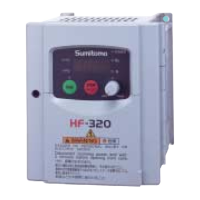
Do you have a question about the Sumitomo SF-320 and is the answer not in the manual?
Introduces the SF-320 and HF-320 series as general-purpose compact inverters.
Highlights V/F control and sensorless vector control capabilities.
Specifies the available voltage classes and power ranges for SF & HF series.
Front cover protects keys, external signals permit use, and allows switching between panel and external signal operation.
Models share dimensions and basic operation for easy selection based on load characteristics.
Covers intelligent terminal, multistep speed change, and PID function.
Applies V/f control for multi-motor applications and PID function for pumps and fans.
Sensorless vector control provides 200% starting torque and high-performance auto-tuning.
Overview of monitoring functions like output frequency, current, and trip status, plus basic settings.
Details common and frequently used functions like frequency command, run command, and speed settings.
Covers auto tuning, motor constant settings, and sensorless vector control tuning for HF-320.
Details the functions of keys, displays, and lamps on the digital operator panel.
Step-by-step guides for setting maximum frequency, running the motor, and monitoring output current.
Explains monitoring functions like output frequency, current, terminal status, and trip history.
Details settings for output frequency, operation direction, base/maximum frequency, and acceleration/deceleration.
Configures frequency scaling for analog input signals (4-20mA or 0-10V).
Covers multispeed settings and jogging operation for positioning.
Explains torque boost for low-frequency operation and V/F characteristic adjustments.
Details DC braking functions and jump frequency settings to avoid resonance.
Enables PID control for precise process management like temperature and pressure.
Covers acceleration/deceleration patterns, restart modes, and 2nd deceleration function.
Details starting frequency adjustment, carrier frequency settings, and data initialization.
Explains STOP key function selection and multifunctional input terminal assignments.
Configures output terminals and selects monitor signals for display.
Allows disabling the STOP key's function, even when external commands are used.
Selects the inverter operation mode after canceling a free-run command.
Assigns functions to input terminals like FR, RST, etc.
Configures output terminals like UPF, DRV, and alarm terminals.
Selects the output monitor signal from FRQ terminal options.
Protects against overcurrent, overload, and sudden heavy loads by cutting off output.
Covers overvoltage and undervoltage protection to safeguard the inverter.
Details EEPROM errors, CPU errors, external trips, and USP errors.
Covers ground fault detection, input overvoltage, undervoltage wait, and thermal protection.
Details power, input/output signal, and operating environment specifications for the SF-320 series.
Details power, control, input/output signal, and environmental specifications for the HF-320 series.
Highlights features and specifications for explosion-proof motors compatible with HF-320.
Describes terminals for power input, motor output, DC reactor, and ground connection.
Explains terminals for monitoring, frequency command, external DC power, and intelligent I/O.
Details assignment of input/output terminal contact conditions (NO/NC) and signal types.
Illustrates fundamental and specific wiring examples for inverter setup and operation.
Provides reference circuits for motor control with brakes and up-down positioning.
Details the reference circuit and parameter settings for implementing PID control.
Presents dimensional drawings for various SF-320 and HF-320 models.
Details wiring for standard accessories like circuit breakers, contactors, and optional components.
Lists specifications for braking resistors, DC reactors, and AC reactors for harmonic control.
Describes zero-phase reactors for input/output sides to reduce noise.
Explains capacitive filters for the input side to reduce noise.
Details LC filters for input and output sides to reduce noise and improve grounding.
Demonstrates noise reduction measures for high and low noise levels using filters.
Shows example connections for the remote operator.
Guides on selecting peripheral equipment, including wiring precautions.
Discusses continuous operation torque characteristics, motor temperature rise, and component lifespan.
Outlines the warranty period, conditions, exclusions, and policies for the inverter.
Details the warranty terms for repaired or returned products.
Emphasizes essential safety measures, proper usage, and specialist wiring.
Lists contact information for Sumitomo offices globally.